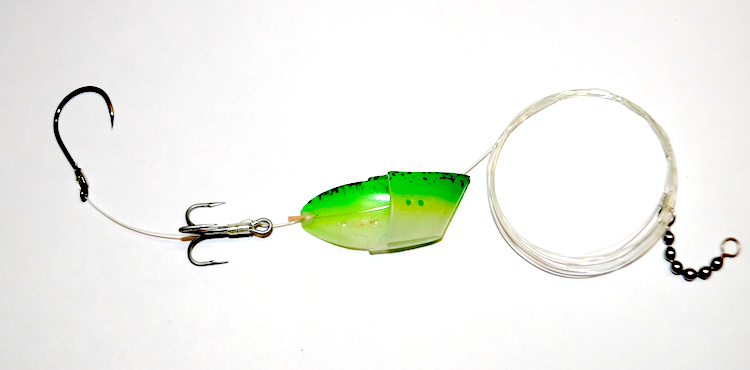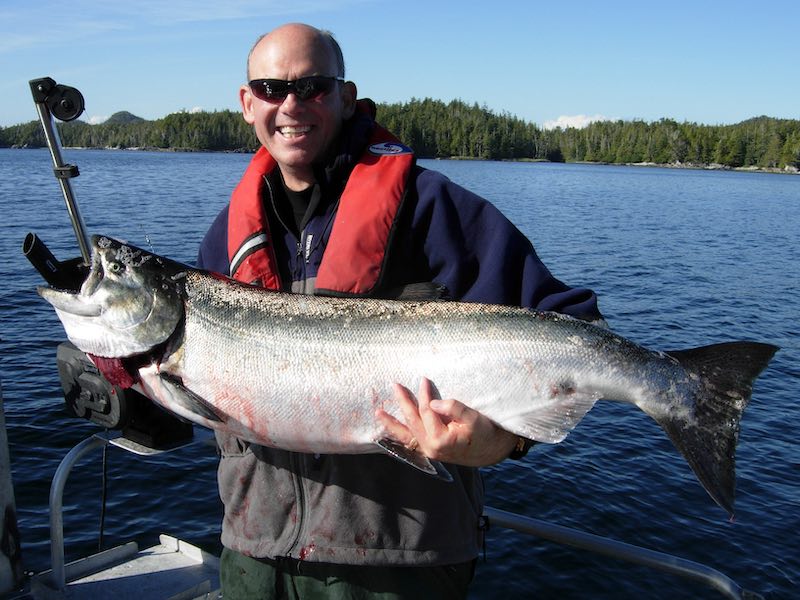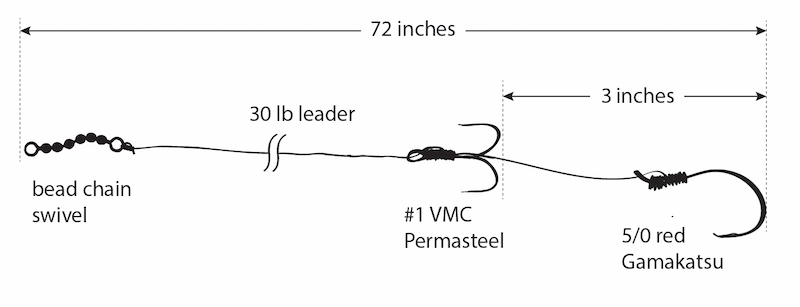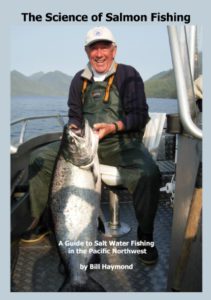
Chinook eat a diet that may include euphausiid, shrimp, squid, sand lance, immature herring, and adult herring, but I believe that the larger chinook—20 lb and above—have a strong bias towards adult herring and pilchards. Big salmon are lazy, and big bait is easier for them to catch than small bait; it also provides a lot more calories. Over the years, I’ve been on waters when perhaps 40 salmon of 50 lb or larger were landed, and I’ve chatted with the fishermen and guides afterwards. Although a few were caught on hardware imitating small bait (for example flashers and hootchies or small spoons) and some were caught on big spoons, the majority of these salmon were caught on big bait.
The trick when fishing big herring is getting it to roll properly. This is easy with the Rhys Davis Super Herring Special teaser head, which is a molded plastic head that is attached to the herring with toothpicks.
Using Teaser Heads
The herring with teaser head can be fished with a flasher or alone in the same manner as a plug or spoon. I use a 6 ft leader so I can use either approach. One flasher is usually enough to attract salmon to the boat, so I often set up one rod with teaser head and flasher and the second rod with teaser head, but no flasher. This is a very effective fishing method. Flasher and teaser head usually catches more salmon than teaser head alone, but I have also seen conditions where the naked teaser head did better. If there are coho in the area, they will usually favour the flasher.
Teaser Heads with Flashers
When fishing with the flasher, it is important that the leader be long without making it difficult to net the fish. Since the rods are typically ten foot, six inches and bend a bit when playing a fish, I’ve found that a six-foot leader is about right. It is also important to use a heavy leader, since the fish can get quite a lot of leverage against the flasher. For personal fishing, I use Maxima 30 lb test, and when guiding I use 40. An advantage of a heavy leader is abrasion resistance—the leader is less likely to break due to nicks and scratches.
The photo above shows some favourite teaser heads. At the top is Green Glow, which is my all time favourite for murky green water conditions. The Green Splatterback glows, but not as brightly, and it also works well in green water. At the bottom is Blue Splatterback, which also glows and is my favourite teaser head in late July and early August when the water clears.
The Rhys Davis Super Herring Special teaser head is designed for blue (7- to 8-in) herring, but I often fish at lodges, which supply herring in the purple and black sizes (8- to 10- in). To accommodate the larger herring I cut open the bottom (short side) of the teaser head.
There are several ways of rigging the teaser head. First I’ll explain the traditional method.
How To Rig A Teaser Head
I use a #1 VMC Permasteel treble hook in the lead and a 5/0 single hook (Gamakatsu—red or black) for the trailer. The treble is important because one of the points is inserted into the herring and is used to draw the herring into a curved shape so it will roll nicely. The other two points on the treble face out- ward to catch on the salmon. The 5/0 trailing single is especially useful when the salmon are tentative and just mouthing the tail of the bait.
How To Tie A Leader For Teaser Heads
To tie the leader, begin with a seven- foot length of 30-lb test line. Attach the 5/0 single trailing hook using the salmon egg loop knot, then attach the treble in front, also with the salmon egg loop knot. There should be exactly three inches separation between the back end of the treble hook and the back end of the single hook. Feed the leader through the two holes in the teaser head, then attach a bead chain swivel.
Insert a dry flat toothpick into the rear hole of the teaser head to tension the line, and clip off the end roughly to 1/8th in. You may consider adding a stick-on eye to the outside of the teaser head. Don’t forget to crimp the barbs and touch up the hooks so they are “sticky” sharp.
I’ve found that the leader often gets nicked or breaks between the two hooks. It is simplest to tie up a number of leaders consisting of the two hooks and the leader material, and to add the appropriate colour teaser head and the bead chain swivel later in the boat. The two hooks and leader material cost about $2 per leader, while the teaser head is an additional $4. I rarely lose teaser heads but tend to go through a lot of leaders, which I package in small zip-lock snack bags. In the boat I save the used hooks from damaged leaders and often tie up new leaders on the spot—I really like the VMC Permasteel and Gamakatsu hooks because they can be re-used many times.
One Comment
Leave A Comment
Visit the Store
$34.99
$34.99
Featured Catch

Joel Unickow halibut (Photo: Rob Frawley Lucky Strike Sportfishing Tofino)












good paragraph